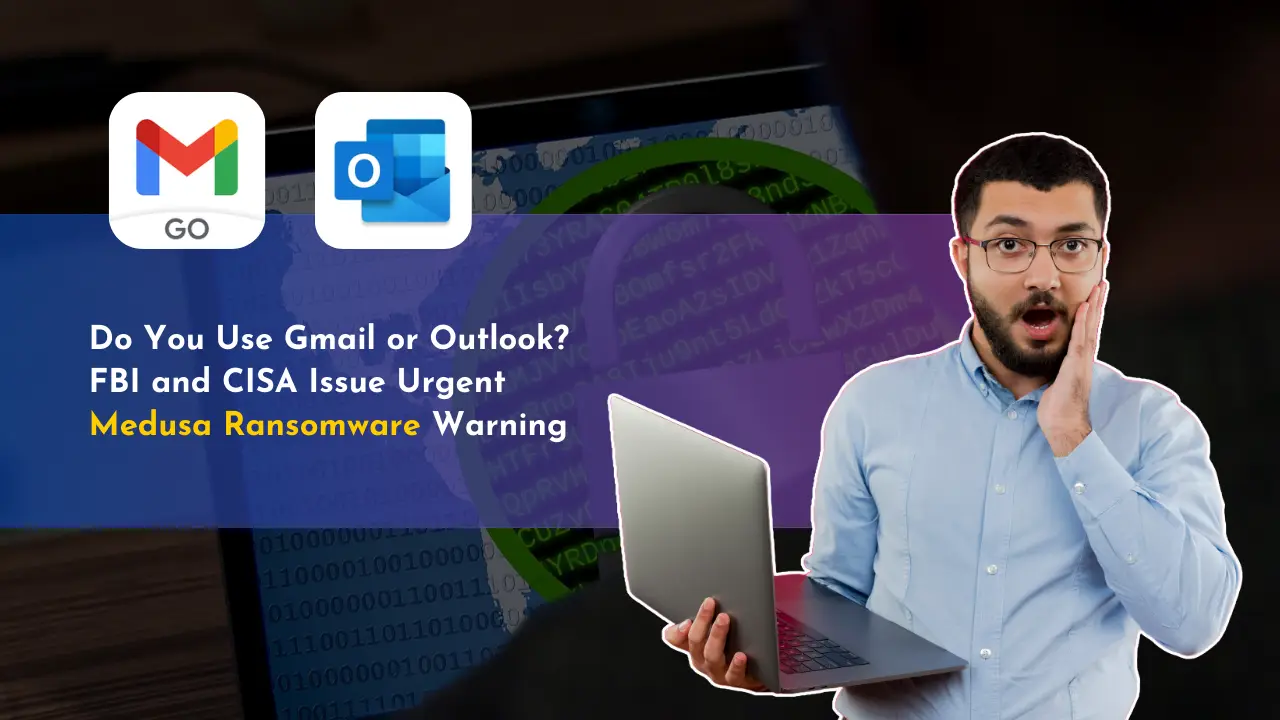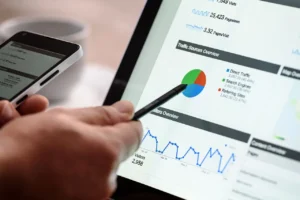Your email account could be the next target of Medusa ransomware, a dangerous threat that has already claimed over 300 victims across critical sectors since 2021. Currently, this ransomware group demands ransoms ranging from $100,000 to $15 million, giving victims just 48 hours to respond before releasing stolen data. As a result of this growing threat, the FBI and CISA have issued an urgent warning to Gmail and Outlook users about this sophisticated attack that combines phishing tactics with outdated software exploitation. The cybercriminal group, known as Spearwing, operates a public data-leak site where they display victim information alongside threatening countdown timers, forcing organizations to choose between paying hefty ransoms or facing data exposure.
FBI Reveals How Medusa Ransomware Targets Email Users
The FBI and CISA have uncovered Medusa ransomware’s sophisticated attack methods targeting Gmail and Outlook users. Medusa developers recruit access brokers, paying them between $100 and $1 million to breach potential victims’ data. These cybercriminals primarily focus on organizations in medical, education, legal, insurance, tech, and manufacturing sectors.
Phishing Campaigns Exploit Gmail and Outlook Vulnerabilities
Medusa ransomware affiliates employ phishing campaigns as their primary method for stealing victim credentials. Subsequently, these attackers use classic strategies to trick recipients into downloading malicious programs, gaining unauthorized access to email accounts. Once inside a system, Medusa operators methodically move through the network until they locate sensitive data.
The attackers exploit various established methods to gain access to private systems:
- Malware deployment
- Vulnerability exploitation
- Brute-force attacks on RDP servers
- Stolen credential usage
Double Extortion Tactics Force Victims to Pay Ransom
Medusa operates through a sophisticated double extortion model, where cybercriminals both encrypt victim data and threaten to publicly release stolen information if ransom demands remain unpaid. The group maintains a .onion data leak site, displaying victim information alongside countdown timers.
Furthermore, Medusa has implemented additional pressure tactics:
- Victims must pay between $100,000 to $15 million in ransom
- Direct communication through phone or email if victims fail to respond
- Option to purchase additional time by paying $10,000 in cryptocurrency to extend the countdown timer
The ransomware group posts ransom demands on their site with direct links to affiliated cryptocurrency wallets. Additionally, Medusa simultaneously advertises the sale of stolen data to interested parties while the countdown timer runs.
In one particularly concerning development, FBI investigations revealed a potential triple extortion scheme. After one victim paid the initial ransom, a separate Medusa actor contacted them, claiming the negotiator had stolen the payment. The actor then demanded half of the original payment again to provide the “true decryptor“.
The double extortion approach proves particularly dangerous because organizations cannot simply rely on data backups. Even if companies restore their systems, the threat of sensitive information being leaked remains. This tactic specifically targets industries handling valuable data, including:
- Government agencies
- Healthcare providers
- Educational institutions
- Critical infrastructure operators
- Financial institutions
Medusa’s attack pattern follows a calculated sequence: first gaining network access, then moving laterally through systems, and finally executing the ransomware while simultaneously exfiltrating sensitive data. This methodical approach maximizes pressure on victims, particularly those in highly regulated sectors where data breaches can cause significant reputational damage.
What Happens When Medusa Infects Your Email Account?
Once Medusa ransomware infiltrates an email system, it launches a sophisticated multi-stage attack designed to maximize damage and pressure victims into paying substantial ransoms. The ransomware group has already compromised more than 300 organizations across various sectors.
Hackers Gain Access to Personal and Financial Information
After breaching email security, Medusa operators systematically extract credentials from web browsers and password managers to expand their access. The attackers utilize multiple legitimate software tools to move laterally through networks, such as AnyDesk, ConnectWise, and Splashtop. Moreover, these cybercriminals employ advanced techniques to disable security software, often using vulnerable drivers in what security experts call ‘bring your own vulnerable driver’ (BYOVD) attacks.
Files Get Encrypted and Held for Ransom
Throughout the attack, Medusa executes a methodical process of data theft and encryption:
- Copies of sensitive files are exfiltrated first
- Remaining files on victim systems receive the “.MEDUSA” extension
- The ransomware executable self-deletes after encryption
The group demands ransom payments ranging from $100,000 to $15 million. Nevertheless, paying the ransom offers no guarantee of data recovery – statistics show that only 4% of victims who pay recover all their data.
Countdown Timer Pressures Victims to Respond Quickly
To intensify psychological pressure, Medusa implements several coercive tactics:
- A 48-hour deadline to initiate contact through Tor browser chat or Tox messaging
- Direct phone or email contact if victims fail to respond
- A countdown timer displaying time remaining until data release
- Option to extend the deadline by paying $10,000 in cryptocurrency
The attackers maintain a dedicated data leak site on the dark web alongside a public Telegram channel where they publish stolen information. On their leak site, Medusa lists compromised organizations next to countdown timers, creating constant pressure through the threat of imminent data exposure.
In certain cases, Medusa has evolved to employ triple extortion schemes. In one documented instance, after a victim paid the initial ransom, another Medusa actor contacted them claiming the negotiator had stolen the payment and demanded an additional 50% of the original amount for the “true decryptor”.
The ransomware group deliberately creates confusion through multiple communication channels – including email, phone, WhatsApp, and social media messages. This calculated chaos aims to induce stress and decision paralysis, pushing victims toward paying the ransom rather than exploring recovery alternatives.
For regulated industries like healthcare and finance, Medusa adds another layer of pressure by threatening to report victims to authorities. The group also offers to sell the stolen data to interested third parties before the countdown expires, creating additional incentives for victims to pay quickly.
Despite promises that paying the ransom will resolve the situation, 78% of victims who pay experience repeat attacks. The group maintains persistence in compromised systems through sophisticated evasion techniques that make detection and removal particularly challenging.
How Can Gmail Users Protect Their Accounts?
Following the FBI’s urgent warning about Medusa ransomware, Gmail users must implement immediate security measures to safeguard their accounts. Google’s internal data shows that Gmail blocks more than 99.9% of spam, phishing attempts, and malware from reaching users. Still, proactive protection remains crucial against evolving threats.
Enable Two-Factor Authentication Immediately
The FBI strongly recommends enabling two-factor authentication (2FA) for all Gmail accounts. This additional security layer proves especially critical for accounts accessing virtual private networks or critical systems. When unusual sign-in attempts occur from unfamiliar locations or devices, Google automatically blocks access and sends alert emails to account owners.
Recognize Suspicious Email Patterns
Gmail’s built-in security features help identify potential phishing attempts through several indicators:
- Warnings appear automatically when emails contain dangerous links or suspicious attachments
- Safe Browsing protection identifies and flags malicious websites before you visit them
- The system moves suspected phishing emails to the spam folder automatically
However, manual vigilance remains essential. Be cautious of messages requesting:
- Personal information like usernames or passwords
- Access to unfamiliar websites
- Immediate action through threatening language
Update Recovery Options for Quick Response
In case Medusa ransomware compromises your account, proper recovery options become crucial for regaining control. Google recommends several preventive measures:
First, verify and update your account recovery information regularly. This includes both a backup email address and phone number. These recovery options prove invaluable when:
- You forget your password
- Someone else gains unauthorized access
- Your account becomes locked for security reasons
Secondly, regularly review your recent account activity through Google’s Security Checkup feature. This tool helps identify:
- Unfamiliar sign-in locations
- Suspicious device access
- Unusual account changes
Upon detecting unauthorized access, Google’s security system immediately blocks suspicious sign-in attempts. Furthermore, encrypted messages at rest and during transit between data centers provide additional protection against interception.
For accounts facing heightened risks, Google offers the Advanced Protection Program with enhanced security features. This program provides maximum defense against targeted attacks, although standard security measures suffice for most users.
When reviewing account security, pay close attention to:
- Recent security events in your Google Account dashboard
- Unfamiliar locations or devices accessing your account
- Changes to recovery information or security settings
If suspicious activity appears, immediately secure your account by:
- Changing your Google Account password
- Updating passwords for linked applications
- Reviewing and revoking access from unfamiliar devices
Remember that Google never requests personal information through email. Therefore, treat any message asking for account credentials with extreme caution. Through consistent application of these security measures, Gmail users significantly reduce their vulnerability to Medusa ransomware attacks.
What Security Measures Should Outlook Users Implement?
Microsoft’s latest security advisory emphasizes robust protection measures for Outlook users against Medusa ransomware threats. The tech giant’s comprehensive defense strategy combines advanced threat detection with user-focused security protocols.
Microsoft’s Advanced Threat Protection Features
Microsoft Defender for Office 365 provides cloud-based email filtering that shields organizations from sophisticated threats. The system automatically scans email attachments for viruses using advanced detection techniques. Upon identifying suspicious content, Defender removes dangerous files before users can accidentally open them.
Safe Links technology actively checks web links in emails, displaying warning messages when malicious content is detected. Furthermore, ATP for SharePoint Online safeguards shared files within organizations by:
- Detecting suspicious files in document libraries
- Blocking malicious content in team sites
- Protecting data stored on OneDrive
Creating Strong, Unique Passwords
Password security forms the foundation of Microsoft’s defense against Medusa ransomware. A strong Outlook password must contain:
- Minimum of 12 characters, ideally 14 or more
- Mix of uppercase letters, lowercase letters, numbers, and symbols
- No dictionary words or personal information
For enhanced protection, Microsoft recommends changing passwords periodically. Outlook Data File passwords should remain unique and separate from Windows login credentials. Additionally, users must store password information in secure locations, away from protected data.
Regular Security Checkups to Identify Vulnerabilities
Microsoft’s security framework incorporates automated monitoring systems that continuously scan for potential threats. The Spoof Intelligence feature detects whether senders use legitimate or spoofed names. Mailbox intelligence analyzes communication patterns to identify phishing attempts automatically.
For optimal security maintenance:
- Review account activity regularly through security dashboards
- Monitor detected threats across email and content
- Analyze incoming security alerts systematically
Microsoft’s ATP includes informative reports combining data about detected threats, malicious emails, and compromised content. The system automatically quarantines suspicious files, allowing administrators to manually restore or delete quarantined data.
For organizations managing multiple Outlook users, Microsoft recommends:
- Implementing network segmentation to prevent ransomware spread
- Filtering network traffic from unknown sources
- Disabling unused ports and maintaining encrypted backups
The platform’s self-learning system models employ complex algorithms for automatic phishing detection. Accordingly, users receive immediate alerts about suspicious activities, enabling quick response to potential threats.
Microsoft’s Advanced Threat Protection maintains continuous surveillance across Exchange, Teams, and OneDrive products. This unified approach ensures comprehensive protection against evolving ransomware tactics, primarily through automated detection and response tools.
What Should You Do If Medusa Ransomware Strikes?
Swift action becomes crucial upon discovering a Medusa ransomware infection in your system. The FBI and CISA have outlined specific protocols to minimize damage and protect sensitive data from this increasingly sophisticated threat.
Immediate Steps to Contain the Damage
First, disconnect infected machines from your network immediately to prevent further spread. Afterward, initiate these critical containment measures:
- Isolate affected devices and transfer uncompromised data to a secure location
- Document all compromised systems through complete damage inventory
- Avoid attempting DIY decryption as it may render future recovery impossible
Early expert evaluation proves essential for understanding available options. Professional data recovery specialists maintain proprietary tools specifically designed to combat ransomware encryption.
When to Report to Authorities
Upon detecting Medusa ransomware, report the incident promptly to government authorities. The FBI, CISA, and U.S. Secret Service coordinate responses through a unified reporting system – one report automatically notifies all relevant agencies.
Notably, organizations must report incidents regardless of whether they pay the ransom. This reporting helps authorities:
- Track emerging threat patterns
- Develop effective countermeasures
- Assist other potential victims
- Combat future attacks
Data Recovery Options Without Paying Ransom
The FBI, CISA, and MS-ISAC strongly advise against paying ransoms. Payment offers no guarantee of data recovery plus encourages further criminal activity. Instead, consider these alternative recovery strategies:
- Implement Recovery Plans
- Maintain multiple copies of sensitive data
- Store backups in physically separate, secure locations
- Ensure backup data remains encrypted and immutable
- Network Protection
- Filter traffic from unknown sources
- Restrict remote access to internal systems
- Monitor for unauthorized scanning attempts
Professional data recovery services often succeed without ransom payment through:
- Specialized proprietary decryption tools
- Just-in-Time custom recovery solutions
- Advanced cryptography techniques
For optimal recovery chances, maintain offline backups of critical data. These backups prove invaluable as they remain inaccessible to ransomware encryption. Furthermore, segment networks to prevent lateral movement between infected and clean devices.
Consider engaging specialized ransomware response teams that offer:
- Free initial consultations
- 24/7 global support
- Dedicated recovery specialists
- Regular progress updates
Success rates vary based on ransomware variant complexity, affected hardware, and initial response timing. Consequently, early professional intervention maximizes recovery possibilities while minimizing potential data loss.
Remember to audit user accounts with administrative privileges and configure access controls according to least privilege principles. Additionally, review domain controllers, servers, workstations, and active directories for unrecognized accounts.
Conclusion
Medusa ransomware stands as a significant threat to email users, demanding ransoms up to $15 million while targeting critical sectors worldwide. Though Gmail and Outlook offer robust security features, your vigilance remains essential for protection against these sophisticated attacks. Security measures like two-factor authentication, strong passwords, and regular security checkups significantly reduce your risk exposure. Additionally, maintaining offline backups and implementing network segmentation helps minimize potential damage.
Rather than paying ransoms, following FBI and CISA guidelines offers better protection for your data. Swift action during an attack, including system isolation and immediate reporting to authorities, proves crucial for successful recovery. Through proper preparation and awareness, you can effectively shield your email accounts from Medusa ransomware threats while ensuring business continuity.




